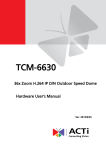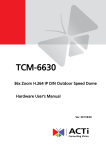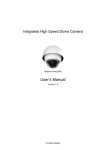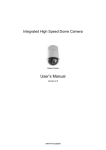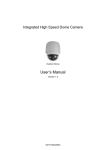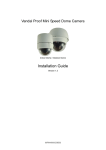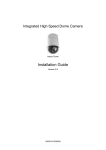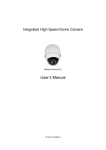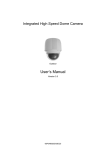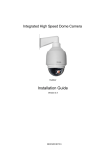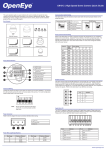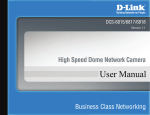Download Vandal Proof Mini Speed Dome Camera - CBC Group
Transcript
Vandal Proof Mini Speed Dome Camera Indoor Dome / Outdoor Dome User’s Manual Version 2.3 00P3H5000ZSEB3 User’s Manual Preface The information given in this manual was current when published. The company reserves the right to revise and improve its products. All specifications are subject to change without notice. Notice To work with the Vandal Proof Mini Speed Dome Cameras, any installer or technician must have the following minimum qualifications: • A basic knowledge of CCTV systems and components • A basic knowledge of electrical wiring and low-voltage electrical hookups • Have read this manual completely Copyright Under copyright laws, the contents of this user manual may not be copied, photocopied, translated, reproduced or reduced to any electronic medium or machine-readable format, in whole or in part, without prior written permission of the company. Important Information Before proceeding, please read and observe all instructions and warnings in this manual. Retain this manual with the original bill of sale for future reference and, if necessary, warranty service. When unpacking your unit, check for missing or damaged items. If any item is missing, or if damage is evident, DO NOT INSTALL OR OPERATE THIS PRODUCT. Contact your dealer for assistance. Regulation This device complies with Part 15 of the FCC Rules. Operation is subject to the following two conditions: (1) this device may not cause harmful interference, and (2) this device must accept any interference received, including interference that may cause undesired operation. 1 User’s Manual This symbol on the product or on its packaging indicates that this product shall not be treated as household waste in accordance with Directive 2002/96/EC. Instead it shall be handed over to the applicable collection point for the recycling of electrical and electronic equipment. By proper waste handling of this product you ensure that it has no negative consequences for the environment and human health, which could otherwise be caused if this product is thrown into the garbage bin. The recycling of materials will help to conserve natural resources. For more details information about recycling of this product, please contact your local city office, your household waste disposal service or the shop where you purchased the product. Compliance is evidenced by written declaration from our suppliers, assuring that any potential trace contamination levels of restricted substances are below the maximum level set by EU Directive 2002/95/EC, or are exempted due to their application. 2 User’s Manual Cautions • Handle the camera carefully Do not abuse the camera. Avoid striking, shaking, etc. The camera could be damaged by improper handing or storage. • Do not disassemble the camera To prevent electric shock, do not remove screws or covers. There are no user serviceable parts inside. Ask a qualified service person for servicing. • Do not block cooling holes on the bracket This camera has a cooling fan inside. Blocking the cooling holes leads to build up heat of the camera and may cause malfunction. • Do not operate the camera beyond the specified temperature, humidity or power source ratings Use the indoor dome camera under conditions where temperature is between 0°C ~ 40°C (32°F ~ 104°F) and the outdoor camera under conditions where temperature is between -30°C~45°C (-22°F~104°F), and humidity is below 90%. • Do not expose the indoor dome camera to rain or moisture, or try to operate it in wet areas The indoor dome camera is designed for indoor use or locations where it is protected from rain and moisture. Turn the power off immediately if the camera is wet and ask a qualified service person for servicing. Moisture can damage the camera and also create the danger of electric shock. • Do not use strong or abrasive detergents when cleaning the camera body Use a dry cloth to clean the camera when it is dirty. In case the dirt is hard to be removed, use a mild detergent and wipe gently. • Never face the camera towards the sun Do not aim the camera at bright objects. Whether the camera is in use or not, never aim it at the sun or other extremely bright objects. Otherwise, the camera may be smeared or damaged. 3 User’s Manual Contents 1. Overview .......................................................................................................................6 1.1 Product Features .................................................................................................7 1.2 Product Application ..............................................................................................8 2. Connecting the Mini Speed Dome...............................................................................9 2.1 Package Content .................................................................................................9 2.2 Switch Definition ................................................................................................10 2.3 Communication Switch Setting .......................................................................... 11 2.4 Dome ID Setup .................................................................................................. 11 2.5 Dome Control Protocol Setup ............................................................................12 2.6 22-Pin Connector Definition ...............................................................................13 2.7 RS-485 Connector Definition .............................................................................15 3. Operation and Configuration.....................................................................................16 3.1 OSD Display Format..........................................................................................16 3.2 OSD Menu Tree.................................................................................................17 3.3 Configuration Menu ...........................................................................................19 3.3.1 DEFAULT CAMERA ..............................................................................20 3.3.2 BACKLIGHT..........................................................................................20 3.3.3 FOCUS..................................................................................................20 3.3.4 AE MODE..............................................................................................20 3.3.5 WBC MODE ..........................................................................................21 3.3.6 SETUP MENU 1....................................................................................22 DIGITAL ZOOM................................................................................22 EXIT.................................................................................................23 3.3.7 SETUP MENU 2....................................................................................23 FLIP .................................................................................................23 ANGLE ADJUSTER .........................................................................24 SPEED BY ZOOM ...........................................................................24 AUTO CALI. (Auto Calibration) ........................................................24 SYSTEM RESET .............................................................................24 EXIT.................................................................................................24 3.3.8 ID DISPLAY...........................................................................................25 3.3.9 TITLE DISPLAY.....................................................................................25 3.3.10 TITLE SETTING ....................................................................................25 3.3.11 PRESET................................................................................................26 3.3.12 SEQUENCE ..........................................................................................27 3.3.13 AUTOPAN .............................................................................................29 3.3.14 CRUISE.................................................................................................30 3.3.15 HOME SETTING ...................................................................................32 3.3.16 IR FUNCTION (Optional) ......................................................................33 3.3.17 ALARM SETTING .................................................................................33 3.3.18 TIME SETTING .....................................................................................35 4 User’s Manual 3.3.19 SCHEDULE FUNCTION .......................................................................36 3.3.20 EXIT OSD .............................................................................................37 Appendix A: Technical Specification .............................................................................38 Appendix B: OSD Menu Notes........................................................................................39 5 User’s Manual 1. Overview The Vandal Proof Mini Speed Dome Camera is an innovative Speed Dome Camera designed for middle and small surveillance applications and possesses true speed dome camera features, such as high speed and accurate Pan/Tilt, up to 10×10 zoom ratio, 180° Mechanical Flip, Speed by Zoom, and Preset Speed up to 360°. Additionally, it contains 256 Preset Points, 8 Sequence, 4 Auto Pan, and 1 Cruise features to support automatic operations. It is ideal for all surveillance requirements in hotels, department stores, intelligent buildings, amusement parks, parking lots, factories, hospitals, schools, stations etc. The Vandal Proof Dome Camera provides two models of new generation advanced DSP color camera: Indoor Vandal Proof Mini Speed Dome Faster and Smoother object tracking capability The most impressive, economical indoor application Compact 4.2”, stylish and intelligent design for easy installation Outdoor Vandal Proof Mini Speed Dome For both indoor and outdoor applications Flexible accessories enable the most effective installations Weather resistant housing and sunshield for harsh environment The Vandal Proof Mini Speed Dome Camera contains various solutions for low light and high contrast conditions. For example, a bright background or shade can result in the subject of the image appearing darker. The backlight compensation function gives a bright and beautiful image. With a vandal proof cover, Vandal Proof Mini Speed Dome Cameras provide strong protections to the domes. With weather resistant housing (IP66 standard) and optional sunshield, Outdoor Dome Cameras can face harsh circumstances. Vandal Proof Mini Speed Dome Cameras support one cabling for easy installation, and can be integrated with CCTV products, such as DVRs, Control Keyboards, and CCTV accessories for a total surveillance solution. The compact 4.2” dome camera is incorporated with multiple protocols: GANZ-PT, Pelco, VCL, Philips, etc. to enhance powerful connectivity. 6 User’s Manual 1.1 Product Features • • • • • • • • • • • • • • • • • • • • • • • 10x (Optical Zoom), 10x (Digital Zoom) 350° Pan Rotation with Horizontal Flip Pan Driver Accuracy of 0.50° Pan & Tilt speed proportional to Zoom Ratio Auto Pan/Sequence/Cruise 256 Preset Points with number displayed 8 Sequence, 4 Auto Pan, and 1 Cruise Preset Speed up to 300°/sec. Backlight Compensation Auto Focus Auto White Balance Auto Gain Control Auto Iris Control Auto Calibration Automatic Mechanical Flip (180°) Removable IR Cut Filter (Optional) Minimum Illumination:1 lux, 0 lux (IR illuminator) Scheduling Functions Multiple Protocol: GANZ-PT, Pelco D & P, VCL, Philips, AD/AD-422, etc. Extraordinary Lightweight Design for Easy Installation Vandal Proof Dome Cover Weather Resistant Housing (Outdoor Dome) Flexible In/Outdoor mounting 7 User’s Manual 1.2 Product Application Connect dome cameras to other devices, as shown in the diagram, to complete a video surveillance solution. NOTE: To extend the network distance up to 1.2 km (4000 feet) and to protect the connected devices, it is highly recommended to place a repeater at the mid-point. However, a repeater may be needed in the network distance less than 1.2 km if the used cables are not the CAT 5, 24-gauge cables (see 2.7 RS-485 Connector Definition). Refer to the repeater’s manual for detailed information. 8 User’s Manual 2. Connecting the Mini Speed Dome Please refer to the following sections to connect, set and operate the dome camera. In order to control the dome camera, basically a control keyboard or other control device is required. 2.1 Package Content Before proceeding, please check the box contains the items listed here. If any item is missing or has defects, DO NOT install or operate the product and contact your dealer for assistance. Indoor Vandal Proof Mini Speed Dome (DC 12V/AC 24V) Hard Ceiling Mount and Decorative Ring 50-cm Data Cable for Power Supply, Video and RS-485 (for DC 12V model) Fixing Plate Self-tapping Screws Plastic Screw Anchors 50-cm Data Cable for Power Supply, Video and RS-485 (for AC 24V model) Quick Guide CD: Operation Manuals Dome Body with 4.2” cover DC Power Adaptor & Power Cord (DC model Only) Outdoor Vandal Proof Mini Speed Dome Dome Body 5.4” Optical Cover Lubricant & Screws 9 User’s Manual Data Cable for Power 2.2 Supply, Video and RS-485 50-cm, 13-pin Alarm Cable Quick Guide CD: Operation Manuals Water-proof Rubber Switch Definition First of all, configuring the dome ID and communication protocol is required before connecting the dome camera to other devices. The switches used for configuring these settings are located on the bottom of the dome camera. Indoor Dome 10 A Reserved B Communication Switch C Dome ID Switch D Dome Control Protocol Switch E RJ-45 Connector (for IP dome only) F 22-Pin Connector G ISP Connector (for FW upgrade) Outdoor Dome User’s Manual 2.3 Communication Switch Setting The table below shows the function of each pin within the Communication Switch. Communication Switch SW 1 SW 2 RS-485 Setting SW 3 Termination SW 4 Line Lock SW 5 System Initialization SW 6 Camera Upgrade RS-485 is the interface that communicates the dome camera and its control device; for this reason, the RS-485 setup of the dome and the control device must be the same. The RS-485 default setting is half-duplex (see the diagram follows). Please do not change the default setting without qualified specialist or supplier’s notice. As for the SW 3 and SW 4, they are used for termination and Line Lock adjustment respectively. The SW 5 is mainly used when users want to restore the camera to the factory default status; moreover, once firmware upgrade is carried out, users need to reset the SW 6 afterward. RS-485 Setting Half-duplex 2.4 Full-duplex Dome ID Setup Please change the dome ID if there is more than one dome on the same installation site. Before installing the dome camera, use the switch to change your speed dome ID by turning the arrow to the desired number respectively. For instance, if the dome ID is 123, the ID switch should be set as shown below. NOTE: No two domes should be given the same ID, or communication conflict may occur. In addition, the number “0” should locate upwards as shown in the diagram for correct switch definition. 11 User’s Manual Centesimal Digit Decimal Digit Single Digit it NOTE: The number “0” should locate upwards as shown in the diagram above for correct switch definition. 2.5 Dome Control Protocol Setup Define the protocol you are going to use basing on the devices of your surveillance system. Generally, use one protocol even the devices are provided from different manufacturers. Use the switch to set your dome control protocol and the baud rate. Refer to the table below and turn the arrow to choose a protocol for your speed dome. Switch No. Protocol Baud Rate 00 VCL 9600 01 Pelco D 2400 02 Pelco P 4800 04 Chiper 9600 05 Philips 9600 07 GANZ-PT 9600 08 AD422 4800 09 DM P 9600 11 Pelco D 4800 12 Pelco D 9600 13 Pelco P 2400 14 Pelco P 9600 15 JVC 9600 Select protocol: Pelco D, with switch no. 01 and baud rate 2400, for instance, the protocol switch should be set as below. Decimal Digit 12 Single Digit User’s Manual NOTE: The number “0” should locate upwards as shown in the diagram above for correct switch definition. 2.6 22-Pin Connector Definition A 50-cm data cable (as shown in the figure below) is shipped with the speed dome for quick installation for demo or testing usage. Additionaly, the section will also provide the definition of each pin within the 22-pin connector on the data cable. For more information about RS-485 connector, see 2.7 RS-485 Connector Definition. DC 12V Data Cable Power Input Video Output RS485 Connector DC12 Female Jack BNC Connector 2 wires 4 wires AC 24V Data Cable 3-Pin Terminal Block Power Input Video Output BNC connector RS485 Connector 2 wires 4 wires 13 User’s Manual NOTE: When wiring the power cable, make sure the G/Y wire (Ground) inserted into the mid-pin of the terminal block. The 22-pin connector definition is listed as follows. 14 Pin Definition Cable 1 AC 24-1/DC (+) 20AWG 2 ALM NC 3 AC 24-2/DC (-) 4 ALM NO 5 FG 6 ALM COM 7 T+ 8 R- 9 T- 10 R+ 11 ISOG 12 ALM-1 13 ALM-3 14 ALM-2 15 ALM-4 16 ALM-5 17 ALM-6 18 ALM-7 19 ALM-8 20 ALM GND 21 VGND 22 Video 20AWG 20AWG 24AWG 24AWG User’s Manual 2.7 RS-485 Connector Definition RS-485 is the interface that communicates the dome camera and its control device. Please connect the control keyboard to the speed dome through the terminal block. The recommended cables for RS-485 communication are CAT 5 cables; maximum cable length for over 24-gauge wire is 4000 feet (1219 meters). If the total cable length exceeds 4000 feet, using a repeater to maintain the signals is recommended. Please refer to the figure and table below for pin definition and wiring. Pin Corresponding Pins (22-Pin Connector) 1 7,10 2~4 Reserved 5 8,9 Definition T+, R+ (D+) T-, R- (D-) 15 User’s Manual 3. Operation and Configuration 3.1 OSD Display Format Information shown on the screen are described in terms of OSD display, position and function description; see the table below. 1 3 2 4 6 5 16 Position Function 1 Focus Modes 2 Backlight 3 Alarm 4 Zoom Ratio 5 Title 6 Camera ID OSD Display Description A Auto Focus Mode M Manual Focus Mode X Back Light Compensation OFF B Back Light Compensation ON ALARM Alarm Message Present Zoom Ratio ×1 (Optical Zoom/Digital Zoom) • Maximum 20 characters for each title. • 16 sets of title are available. Show the camera ID User’s Manual 3.2 OSD Menu Tree The OSD setup menu structure is listed in the following section. The star symbol indicates the factory default. For detailed function description, please see section 3.3 Configuration Menu. Indoor/Outdoor Vandal Proof Mini Speed Dome Camera Menu Tree Item LANGUAGE DEFAULT CAMERA BACKLIGHT FOCUS Layer 1 English Layer 2 Layer 3 Default <ON>, <OFF> ON <ON>, <OFF> <AUTO>, <MANUAL> OFF <OFF>, EXPOSURE VALUE: <-10.5dB> ~ <10.5dB> IRIS VALUE IRIS <CLOSE>, <F1.6> ~ <F28> AE MODE AUTO SHUTTER SPEED SHUTTER <1/50> ~ <1/10000> SEC. EXIT YES AUTO (Auto White Balance) INDOOR OUTDOOR R GAIN <000> ~ <127> MANUAL B GAIN <000> ~ <127> ZOOM SPEED <1> DIGITAL ZOOM <ON>, <OFF> ENTER SLOW SHUTTER NONE APERTURE <01> EXIT <YES> FLIP <OFF>, <M.E.> ADJUST MIN ANGL <-10> ~ <+10> DEG ANGLE ADJUSTER ADJUST MAX ANGL <080> ~ ENTER <100> DEG SPEED BY ZOOM <ON>, <OFF> AUTO CALI. <ON>, <OFF> SYSTEM RESET <YES> EXIT <YES> <ON>, <OFF> <ON>, <OFF> <01> ~ <16> PRESET SET <001>~<256> PRESET RUN <001>~<256> EXIT YES SEQUENCE LINE <1> ~ <8> SEQUENCE POINT <01> ~ <32> <001> ~ <255>, PRESET POS. <END> ENTER SPEED <01> ~ <15> <000> ~ <127> DWELL TIME Sec. RUN SEQUNECE ENTER EXIT <YES> ENTER AUTOPAN LINE <1> ~ <4> EXPODURE COMP. AE MODE WBC MODE SETUP MENU 1 SETUP MENU 2 ID DISPLAY TITLE DISPLAY TITLE SETTING PRESET SEQUENCE AUTOPAN ☆ 1 ON OFF 00 90 OFF OFF ON OFF 01 ENTER ENTER ENTER 1 01 001 01 000 1 17 User’s Manual Item Layer 1 Layer 2 START POINT END POINT CRUISE ENTER DIRECTION SPEED RUN AUTOPAN EXIT RECORD START RECORD END RUN CRUISE EXIT HOME FUNCTION SELECT MODE HOME SETTING ENTER PRESET POINT SEQUENCE LINE AUTOPAN LINE CRUISE LINE RETURN TIME GO EXIT IR FUNCTION (Optional) ALARM ACTION ENTER PRESET POINT SEQUENCE LINE AUTOPAN LINE CRUISE LINE DWELL TIME EXIT ALARM DETECT PRIVACY MASK Right 01 OFF ☆ 001 001 <1> ~ <8> <ON>, <OFF> <NO>, <NC> PRESET SEQUENCE AUTOPAN CRUISE <001> ~ <256> <1> ~ <8> <1> ~ <4> <1> <001> ~ <127> SEC, <ALWAYS> YES 1 OFF NC ☆ 001 ALWAYS <NONE> <NONE> TIME SETTING ENTER SCHEDULE SCHEDULE SWITCH POINT HOUR MINUTE MODE TIME DISPLAY SET YEAR SET MONTH SET DAY SET HOUR SET MINUTE EXIT+SAVE <ON>, <OFF> <01> ~ <32> <00> ~ <23> <00> ~ <59> NONE PRESET SEQUENCE AUTOPAN 18 ENTER ENTER ENTER ENTER <ON>, <OFF> PRESET SEQUENCE AUTOPAN CRUISE <001> ~ <256> <1> ~ <8> <1> ~ <4> <1> <000> ~ <128> MIN. ENTER YES Default <AUTO>, <ON>, <OFF> ALARM PIN ALARM SWITCH ALARM TYPE ALARM SETTNG Layer 3 <TO FIND>, <TO SAVE> <TO FIND>, <TO SAVE> <RIGHT>, <LEFT> <01> ~ <04> <ON>, <OFF> <00> ~ <99> <01> ~ <12> <01> ~ <31> <00> ~ <23> <00> ~ <59> YES OFF 01 00 00 NO FUNCTION PRESET POINT <001> ~ <256> SEQUENCE LINE <1> ~ <8> AUTOPAN LINE <1> ~ <4> OFF ☆ User’s Manual Item EXIT OSD 3.3 Layer 1 Layer 2 Layer 3 CRUISE CRUISE LINE <1> Default YES Configuration Menu The detailed functions and parameter setting of your speed dome can be set by the OSD (On Screen Display) menu with a control device such as a control keyboard. The tables below show each page of the OSD menu. Additionally, Appendix B provides a table for user’s setting record. To enter the OSD menu of the selected camera, press <CAMERA MENU> key on the control keyboard and hold for 3 seconds to enter the OSD menu. To select the setup item, use direction keys on keyboard to move the OSD cursor in the OSD menu. To setup item, use direction keys on keyboard to move the OSD cursor in the OSD menu. For items with →, press right/left direction keys on the control keyboard to select. For items with ↓, press the <CAMERA MENU> key on the control keyboard to enter the sub menu. For items with →↓, users can use the right/left direction keys to select functions, and then press the <CAMERA MENU> key on the control keyboard to enter their sub menu. For further detailed setup procedures, please refer to the user’s manual of your installed control devices. NOTE: In the Camera OSD menu, the <CAMERA MENU> key functions as “ENTER” and “EXIT.” 19 User’s Manual 3.3.1 DEFAULT CAMERA The item is for restoring the camera settings (e.g. Backlight / Focus / AE / WBC). Once any one of the parameters is modified, DEFAULT setting will become <OFF> automatically. Select <ON> for this item to recall the mentioned camera parameters. 3.3.2 BACKLIGHT The Backlight Compensation function prevents the center object from being too dark in surroundings where excessive light is behind the center object. Set this item to <ON>; the center object will be brightened in contrast to the edge of the picture (where backlight would most likely be located). 3.3.3 FOCUS The dome camera’s focus can be operated in two modes: Manual Focus mode and Auto Focus mode. • AUTO Optimum focus is achieved by the internal digital circuit. • MANUAL In this focus mode, users can adjust the lens focus manually by pressing the Focus Near / Far button on the control keyboard or other control devices. 3.3.4 AE MODE Exposure is the amount of light received by the image sensor and is determined by how wide you open the lens diaphragm (iris adjustment), by how long you keep the sensor exposed (shutter speed), and by other exposure parameters. With this item, users can define how the Auto Exposure (AE) function works. • EXPOSURE COMPENSATION The exposure value rages from -10.5dB ~ 10.5dB. Select <OFF> to disable the function. 20 User’s Manual • AE MODE AUTO In this mode, the camera’s Brightness, Shutter Speed, IRIS and AGC (Auto Gain Control) control circuits work together automatically to get consistent video output level. SHUTTER With this option, Shutter Speed takes main control of exposure, and both IRIS and AGC will function automatically in cooperation with shutter speed to achieve consistent exposure output. The shutter speed ranges from 1/10000 ~ 1/50. IRIS With this option, the IRIS function adjusts exposure in higher property. SHUTTER speed and AGC circuit will function automatically in cooperating with IRIS to get consistent exposure output. The opening of a lens controls the amount of light reaching to the surface of the selected device. By increasing the F-stop number (F1.6, F2, F2.4, etc.), less light is permitted to pass; options range from F1.6 ~ F28. • EXIT Exit the AE MODE menu and go back to the Main Page 1 to continue to set the WBC mode. MAIN PAGE 1 LANGUAGE ENGLISH DEFAULT CAMERA OFF BACKLIGHT OFF FOCUS AUTO AE MODE ENTER WBC MODE AUTO SETUP MENU 1 ENTER SETUP MENU 2 ENTER 3.3.5 WBC MODE A digital camera needs to find reference color temperature, which is a way of measuring the color of a light source, for calculating all the other colors. The unit for measuring this ratio is in degree Kelvin (K). You can select one of the White Balance Control modes according to the installation condition. The following table shows the color temperature of some light sources. 21 User’s Manual Light Sources Color Temperature in K Cloudy Sky 6,000 to 8,000 Noon Sun and Clear Sky 6,500 Household Lighting 2,500 to 3,000 75-watt Bulb 2,820 Candle Flame 1,200 to 1,500 • AUTO In this mode, white balance works within its color temperature range. This mode computes the white balance value output using color information from the entire screen. • INDOOR 3200 K Base mode. • OUTDOOR 5800 K Base mode. • MANUAL In this mode, users can change the White Balance value manually; R gain and B gain are adjustable and range from 0 to 127. WBC MENU R GAIN B GAIN 3.3.6 50 50 SETUP MENU 1 The SETUP MENU 1 is shown as below. SETUP MENU 1 ZOOM SPEED 1 DIGITAL ZOOM ON SLOW SHUTTER NONE APERTURE 01 EXIT YES The parameters of zoom speed and aperture are fixed. Users could choose whether to activate digital zoom. Refer to the description follows for further details of the function. • DIGITAL ZOOM With this item, users can enable or disable the 10× Digital Zoom. The 22 User’s Manual Digital Zoom will start to activate after the full Optical Zoom level is reached. Maximum 10× digital zoom function is allowed to be enabled. The default setting is <ON>. NOTE: The difference between optical and digital zoom is that optical zoom uses the lens within the camera to draw the image closer via zoom in or out to achieve the desired effect. Optical zoom remains the same resolution of the zoomed image quality. On the other hand, Digital zoom takes a portion of image and expands that image to the full size of the image; the image quality will be reduced. • EXIT Exit the SETUP MENU 1 and go back to the MAIN PAGE 1 to set other functions under the setup menu 2. MAIN PAGE 1 LANGUAGE ENGLISH DEFAULT CAMERA OFF BACKLIGHT OFF FOCUS AUTO AE MODE ENTER WBC MODE AUTO SETUP MENU 1 ENTER SETUP MENU 2 ENTER 3.3.7 SETUP MENU 2 The SETUP MENU 2 is shown as below. SETUP MENU 2 FLIP ENTER ANGLE ADJUSTER ENTER SPEED BY ZOOM OFF AUTO CALI. OFF SYSTEM RESET YES EXIT YES • FLIP Users can track an object continuously when it passes by the dome camera by setting Flip to the M.E. mode (mechanical flip). FLIP SETTING FLIP EXIT+ SET OFF YES M.E. M.E. is a standard mechanical operation. As the dome tilts to the 23 User’s Manual maximum angle, it will pan 180°, and then continue tilting to keep tracking objects. OFF Select this item to disable the flip function. NOTE: To make the dome tilt between a specific range, such as -10° to +100°, please go to ANGLE ADJUSTER (see next section) to set the angle range of tilt. Otherwise, the dome will tilt 90° as the default setting. • ANGLE ADJUSTER The item is for adjusting the camera view angle. The range of view angle is between -10° and +100°. ANGLE ADJUSTER ADJUST MIN ANGLE -10 DEG ADJUST MAX ANGLE 100 DEG EXIT+SAVE YES • SPEED BY ZOOM If the item is set to <ON>, the pan/tilt speed will be adjusted by internal algorithm when zooming automatically. The larger zoom ratio leads to the lower rotation speed. • AUTO CALI. (Auto Calibration) There are one horizontal and one vertical infrared ray check points in each dome. When the dome camera’s position is moved during installation or maintenance, the relative distance between the original set point and the check point could be changed. Enable the Auto Calibration function, the dome will automatically detect the distance change and reset the point back to the original position. • SYSTEM RESET Select this item for remote resetting. • EXIT Exit the SETUP MENU 2 and go to the MAIN PAGE 2 to carry on setting other functions. 24 User’s Manual MAIN PAGE 2 ID DISPLAY ON TITLE DISPLAY OFF TITLE SETTING 01 PRESET ENTER SEQUENCE ENTER AUTOPAN ENTER CRUISE ENTER HOME SETTING ENTER 3.3.8 ID DISPLAY Users are allowed to choose whether the dome ID will be displayed on the monitor to identify each dome. For more information, please refer to section 2.4 Dome ID Setup. • ON Display the ID of the selected dome on the right bottom of the monitor screen. • OFF Hide the ID of the selected dome. 3.3.9 TITLE DISPLAY Users are allowed to name a certain view area and display its title for easy recognition. With this item, users can choose to display or not to display the titles set in advance. • ON A title set for certain view will be displayed when the dome stays in the view area. • OFF When the TITLE DISPLAY is set <OFF>, no title will be displayed on the screen even titles are set in advance. 3.3.10 TITLE SETTING Up to 16 zone titles can be set with maximum 20 characters for each title. Follow the steps to set a camera title. STEP 1: Operate the dome to a view area where you want to set a title for it. STEP 2: Turn on the OSD and go to the MAIN PAGE 2 to select <TITLE 25 User’s Manual SETTING>. STEP 3: Select a number to represent the view area. STEP 4: Press the <CAMERA MENU> key (ENTER) to go into the editing page. TITLE SETTING: 01 0 A K U [ 1 B L V ] 2 C M W + 3 D N X ? 4 E O Y - 5 F P Z 6 G Q : 7 H R / 8 I S . 9 J T , EXIT SAVE LEFT RIGHT DELETE TITLE: ABC STEP 5: Choose a character with direction keys and then press the <CAMERA MENU> key (ENTER) to input. For example: <A> < CAMERA MENU>, <B> <CAMERA MENU>, <C> <CAMERA MENU> TITLE: ABC STEP 6: To delete input characters, move the cursor to <LEFT> or <RIGHT> and press <CAMERA MENU> to select a character in the entry field. Then move the cursor to <DELETE> and press <CAMERA MENU> to delete the selected character. STEP 7: When the setting is completed, move the cursor to <SAVE> and press <ENTER> to save. After completing tile setting, go back to the MAIN PAGE 2 to carry on setup of preset points. MAIN PAGE 2 ID DISPLAY ON TITLE DISPLAY OFF TITLE SETTING 01 PRESET ENTER SEQUENCE ENTER AUTOPAN ENTER CRUISE ENTER HOME SETTING ENTER 3.3.11 PRESET • PRESET SET Totally 256 preset points can be set. Follow the steps below when in the preset setting menu. STEP 1: Press the right/left key on the keyboard to select a number (1 represents preset point 1, 2 represents preset point 2, etc.) STEP 2: Press the <CAMERA MENU> key (ENTER) on the keyboard, 26 User’s Manual and then rotate the dome camera to a targeted shooting area/point. STEP 3: Press the <CAMERA MENU> key again to save the defined preset point. Once completing setup of a preset point, users could move the cursor to the next item to run the preset point. • PRESET RUN Select the preset point that you want to execute. After pressing “ENTER”, the camera will turn to the appointed point. • EXIT Exit the PRESET menu and go back to the MAIN PAGE 2 to carry on setup of sequence. MAIN PAGE 2 ID DISPLAY ON TITLE DISPLAY OFF TITLE SETTING 01 PRESET ENTER SEQUENCE ENTER AUTOPAN ENTER CRUISE ENTER HOME SETTING ENTER Users could set preset points through a keyboard. Please refer to the control keyboard’s quick guide for further information. 3.3.12 SEQUENCE The function executes pre-positioning of the pan, tilt, zoom and focus features in a certain sequence for a camera. Before setting this function, users must preset at least two preset points. SEQUENCE SEQUENCE LINE SEQUENCE POINT PRESET POSITION SPEED DWELL TIME RUN SEQUENCE EXIT 1 01 001 01 001 ENTER YES • SEQUENCE LINE There are eight sets of sequence lines built in the dome camera. Using 27 User’s Manual LEFT/RIGHT direction keys to select a line first and then set its sequence points. • SEQUENCE POINT Up to 32 points can be specified for each sequence line. The sequence points represent order of the preset points that the dome will automatically run. The following setup items, including PRESET POSITION, SPEED and DWELL TIME, will influence how the camera runs through each sequence point. • PRESET POSITION Users can assign a specific preset position to the selected sequence point with this item. • SPEED Users can set the speed of one sequence point to the next one, and the range of setup speed is from 1 to 15. Within the range, PAN speed varies from 10 ~ 400(degree/sec.), and TILT speed varies from 8 ~ 400(degree/sec.). • DWELL TIME The DWELL TIME is the duration time that the dome will stay at a sequence point, and the range is from <0> to <127> seconds. The dome will go to the next sequence point when the DEWEL TIME expires. If the setting is <0>, the dome will stay at this sequence point until users manually move the dome. • RUN SEQUENCE Users can command the dome camera to run the selected sequence line manually. • EXIT Select the item to exit the SEQUENCE menu; go back to the MAIN PAGE 2 to carry on setup of auto-pan. MAIN PAGE 2 ID DISPLAY ON TITLE DISPLAY OFF TITLE SETTING 01 PRESET ENTER SEQUENCE ENTER AUTOPAN ENTER CRUISE ENTER HOME SETTING ENTER 28 User’s Manual Users could execute the sequence function through a keyboard. Please refer to the control keyboard’s quick guide for further information. 3.3.13 AUTOPAN Auto-pan means motion of scanning an area horizontally so that the dome camera can catch horizontal view. The parameters are listed as follows. AUTOPAN AUTOPAN LINE START POINT END POINT DIRECTION SPEED RUN AUTOPAN EXIT 1 TO FIND TO FIND RIGHT 01 ENTER YES • AUTOPAN LINE There are four sets of auto-pan line built in a dome camera. Users can choose a line to execute using LEFT/RIGHT direction keys. In addition, users are able to command the dome camera to do endless panning by setting the start point the same as the end point. • START POINT Follow the description below to set the start position of the AUTOPAN path. 1. Move the cursor to <START POINT> and press <ENTER> while the item, <TO FIND>, is flashing. Then the item will turn <TO SAVE> automatically. 2. Move the dome to a desired position and press <ENTER> to save the position as the start point; the cursor will move to <END POINT> automatically. Ensure setting the end point to complete auto-pan setting. NOTE: The tilt and zoom values of the start point will be recorded and fixed for the selected auto-pan line. • END POINT Users are able to set the end point after the start point is defined. Pan the dome to another position and press <ENTER> to save the position as the end point. • DIRECTION The item is for setting the AUTOPAN direction of the dome camera. The 29 User’s Manual dome will start to pan clockwise from the start point to the end point if your selection is <RIGHT>, and then return to the start point. The dome will start to pan anti-clockwise from the start point to the end point if your selection is <LEFT>. Refer to the diagram below. Start Point RIGHT LEFT (anti-clockwise) Dome Camera LEFT RIGHT (clockwise) End Point • SPEED The item is for defining the dome camera rotation speed while running auto-pan. The speed is adjustable from 1 to 4 (10 ~ 45 degree/sec.). • RUN AUTOPAN After all setting related to auto-pan are completed, select this item to execute the Auto-pan function. • EXIT Exit the AUTOPAN setup menu; go back to the MAIN PAGE 2 to carry on setup of cruise. MAIN PAGE 2 ID DISPLAY ON TITLE DISPLAY OFF TITLE SETTING 01 PRESET ENTER SEQUENCE ENTER AUTOPAN ENTER CRUISE ENTER HOME SETTING ENTER Users could execute the auto-pan function through a keyboard. Please refer to the control keyboard’s quick guide for further information. 3.3.14 CRUISE CRUISE is a route formed with manual operation, through adjusting pan and tilt position, which can be stored and recalled to execute repeatedly. 30 User’s Manual CRUISE RECORD START RECORD END RUN CRUISE EXIT ENTER ENTER ENTER YES • RECORD START Follow the description below to record the CRUISE path. 1. Rotate the dome camera to a desired view area (for some protocols, users may need to do it before entering the OSD), and press <ENTER> to build the cruise path using the joystick on the control device. The percentage of the memory buffer will be displayed on the screen. 2. Pan and tilt the dome camera to form a path. NOTE: Beware of the memory size when building a cruise path. Once the buffer percentage reaches 100%, recording of the path will stop. • RECORD END The cursor will be moved to RECORD END while building the cruise line; when the setting is completed, press <ENTER> to save the path. • RUN CRUISE After cruise setting is completed, select this item to execute the Cruise function. • EXIT Exit the CRUISE setup menu ; go back to the MAIN PAGE 2 to carry on setup of home setting. MAIN PAGE 2 ID DISPLAY ON TITLE DISPLAY OFF TITLE SETTING 01 PRESET ENTER SEQUENCE ENTER AUTOPAN ENTER CRUISE ENTER HOME SETTING ENTER Users could execute the cruise function through a keyboard. Please refer to the control keyboard’s quick guide for further information. 31 User’s Manual 3.3.15 HOME SETTING Users are able to set an operation mode to ensure constant monitoring; if the dome idles for a period of time, the pre-set function will be activated automatically. HOME function allows constant and accurate monitoring to avoid the dome stopping or missing events. HOME SETTING HOME FUNCTION SELECT MODE PRESET POINT RETURN TIME GO EXIT OFF PRESET 001 001 MIN. ENTER YES • HOME FUNCTION The item is used to enable or disable the HOME function. Use the left/right direction keys of the control keyboard to change the setting. • SELECT MODE Select one of the modes that the dome should execute when HOME function is enabled and the RETURN TIME is up. The options include <AUTOPAN>, <SEQUENCE>, <CRUISE> and <PRESET>. Use the left/ right direction keys on the control keyboard to change the setting, and the items mentioned below will change in cooperating with your selection. PRESET Select a preset point where the dome should go when an alarm pin is triggered. SEQUENCE Select a sequence line that the dome camera should execute when an alarm pin is triggered. The Sequence line should be defined previously in the SEQUENCE setup menu. AUTOPAN Select an auto-pan line that the dome camera should execute when an alarm pin is triggered. The Auto-pan line can be defined in the AUTOPAN setup menu. CRUISE Select a cruise line that the dome camera should execute when an alarm pin is triggered. The Cruise line can be defined in the CRUISE setup menu. • RETURN TIME The dome starts to count down RETURN TIME when the dome idles, and 32 User’s Manual it will execute the SELECT MODE function if the return time is up. The RETURN TIME ranges from 1 to 128 minutes. • GO If HOME function is enabled, the users are allowed to execute HOME function manually by selecting this item. • EXIT Exit the HOME SETTING menu. Then go to the MAIN PAGE 3 to carry on other setups. MAIN PAGE 3 IR FUNCTION NONE/AUTO ALARM SETTING ENTER ALARM DETECT NONE PRIVACY MASK NONE TIME SETTING ENTER SCHEDULE ENTER EXIT OSD YES 3.3.16 IR FUNCTION (Optional) With the IR cut filter, the dome can still catch clear image at night time or in the very dark light condition. During day time, the IR cut filter will be on to block the infrared light for clear image; during night time or in dark light condition, the IR cut filter will be removed to catch infrared light, and the displayed images will become black and white. • AUTO The Internal circuit will automatically decide the occasion to remove the IR cut filter according to the value of light condition calculated by the internal light algorithm. • ON Select the item to remove the IR cut filter. • OFF Select the item to disable IR function 3.3.17 ALARM SETTING The Mini Speed Dome provides eight alarm inputs and one alarm output (N.O. and N.C) to connect alarm devices. With this function, a dome will cooperate with alarm system to catch the event images. For wiring, please refer to the 33 User’s Manual installation guide and/or qualified service personnel. Adjustable alarm parameters are listed below. ALARM SETTING ALARM PIN ALARM SWITCH ALARM TYPE ALARM ACTION PRESET POINT DWELL TIME EXIT 1 OFF NC PRESET 001 ALWAYS YES • ALARM PIN The dome provides 8 alarm inputs and 1 relay output (1× N.O. and 1× N.C.). Select an alarm pin which you want to set its alarm-related parameters, and then set its alarm-related parameters in the Alarm Setting menu. For alarm pin definitions, please refer to section 2.6 22-Pin Connector Definition or the installation guide. • ALARM SWITCH The item is used to enable or disable the selected alarm pin function. Use the left/right direction keys on the control keyboard to change the setting. • ALARM TYPE There are two kinds of alarm types: Normal Open and Normal Close, which are illustrated as below. Select an alarm type that corresponds with the alarm application. Alarm In Normal Open Alarm In Normal Close • ALARM ACTION The alarm actions include PRESET, SEQUENCE, AUTOPAN and CRUISE functions. Select one of these modes so that certain action will be executed when an alarm is triggered. Use the right direction key of the control keyboard to select a particular action mode, and the items listed below will change in accordance with your selected alarm action. • PRESET POINT Select a preset point where the dome should go when an alarm pin is 34 User’s Manual triggered. The preset point(s) should be set prior either in the PRESET setup menu or through the keyboard. SEQUENCE LINE Select a sequence line that the dome camera should execute when an alarm pin is triggered. The sequence line(s) should be defined prior either in the SEQUENCE setup menu or through the keyboard. AUTOPAN LINE Select an auto-pan line that the dome camera should execute when an alarm pin is triggered. The auto-pan line(s) should be defined prior either in the AUTOPAN setup menu or through the keyboard. CRUISE LINE Select a cruise line that the dome camera should execute when an alarm pin is triggered. The cruise line should be defined prior either in the CRUISE setup menu or through the keyboard. • DWELL TIME The DWELL TIME is duration of executing an alarm action. If select the PRESET mode, when alarm takes place, the dome will go to the selected preset position and stay there for a user-defined period of time (1~127seconds/Always). If select other modes (SEQUENCE/AUTOPAN/ CRUISE), the dome will keep executing the selected mode (DWELL TIME: ALWAYS) until alarm condition is released or users rotate the dome. NOTE: The dwell time is only adjustable when selecting Preset as the alarm action. • EXIT Exit the ALARM SETTING menu and go back to the MAIN PAGE 3 to carry on time setting. MAIN PAGE 3 IR FUNCTION NONE/AUTO ALARM SETTING ENTER ALARM DETECT NONE PRIVACY MASK NONE TIME SETTING ENTER SCHEDULE ENTER EXIT OSD YES 3.3.18 TIME SETTING The time setting function is used to set the TIME related parameters of the integrated high speed dome. Each item in the menu is listed as follows. 35 User’s Manual TIME SETTING TIME DISPLAY SET YEAR SET MONTH SET DAY SET HOUR SET MINUTE EXIT+SAVE OFF 00 01 00 00 00 YES • TIME DISPLAY Select <ON> to display Time information on the screen or <OFF> not to display. • YEAR / MONTH / DAY The items are for setting up the system date. • HOUR / MINUTE The items are for setting up the system time. • EXIT+SAVE Exit the TIME SETTING menu and go back to the MAIN PAGE 3 to carry on setup of schedule. MAIN PAGE 3 IR FUNCTION NONE/AUTO ALARM SETTING ENTER ALARM DETECT NONE PRIVACY MASK NONE TIME SETTING ENTER SCHEDULE ENTER EXIT OSD YES 3.3.19 SCHEDULE FUNCTION The schedule function enables users to program a preset point or function (Sequence/Auto-pan/Cruise) automatically to perform in a specific period of time. SCHEDULE SWITCH POINT HOUR MINUTE MODE PRESET POINT SCHEDULE RESET EXIT 36 OFF 00 00 00 PRESET 001 YES YES User’s Manual • SCHEDULE SWITCH Select <ON> to enable or <OFF> to disable the schedule function. • SCHEDULE POINT Users are allowed to arrange 32 sets of schedule point, i.e. each set of schedule point can be assigned one kind of schedule modes. • SCHEDULE HOUR / MINUTE The items are for setting up the time to execute each schedule point. • SCHEDULE MODE This is for setting the schedule function of the selected schedule point; the options are listed as follows. NONE No action will be executed for the schedule if select the item. PRESET Users can select the PRESET mode as an action carried out in a schedule point. SEQUENCE Users can select the SEQUENCE mode as an action carried out in a schedule point. AUTOPAN Users can select the AUTOPAN mode as an action carried out in a schedule point. CRUISE Users can select the CRUISE mode as an action carried out in a schedule point. • SCHEDULE RESET Users can reset the whole schedule with the item. • SCHEDULE EXIT Exit the SCHEDULE menu and go back to the MAIN PAGE 3. 3.3.20 EXIT OSD To exit the OSD setup menu, users can either select this item on the bottom of MAIN PAGE 3 or press the ESC key on the control keyboard. 37 User’s Manual Appendix A: Technical Specification Items CAMERA CCD Sensor Optical Zoom Digital Zoom NTSC Effective Pixels PAL Horizontal Resolution Scanning System Synchronization Video Output S/N Ratio Minimum Illumination Focal Length Focus Mode White Balance Iris Control NTSC Electronic Shutter PAL AGC control Back Light Compensation OPERATION Built-in Protocol Pan Travel Tilt Travel Manual Speed Presets Pan Preset Accuracy Tilt Pan Preset Speed Tilt Cruise Sequence Auto Pan Proportional Pan & Tilt Resume after Power loss Zone Title Home Function Auto Flip Day/Night: IR Cut Filter Alarm Input Alarm Output Alarm Reaction GENERAL Environment Controller Interface Operating Temperature Weather Proof Standard Dimension Weight Power Source Power Consumption Regulatory Indoor Outdoor 1/4" SuperHAD CCD 10x 1/4" ExView CCD 10x 1× ~ 10× variable 380k 440k 450 TVL NTSC / PAL Internal 1.0 Vp-p / 75 Ω, BNC > 50 dB (AGC OFF) 1 lux; 0 lux (IR illuminator) 4~40 mm Auto / Manual Auto / Manual Auto / Manual 1/60~1/30k sec. 1/50~1/30k sec Auto / Manual On / Off GANZ-PT, Pelco, VCL, Philips, AD-Manchester, AD-422, JVC, Kalatel, etc. 350° -10°~100° 0.5°~55°/s 256 0.5° (F Type Motor) / 0.125° (G Type Motor) 0.5° 5°~300°/s 5°~300°/s 1 8 4 On/Off (Pan and tilt speed proportional to zoom ratio) Yes 16 Preset, Sequence, Auto pan, Cruise Mechanical/Off On/Off 8 1 Preset, Sequence, Auto pan, Cruise Indoor RS-485 0°C~40°C (32°F~104°F) - Outdoor RS-485 -30°C~45°C (-22°F~104°F) IP 66 Standard ∅172*260mm (6.8*10.2 Inches) ∅133*173mm (5.2x7.6 Inches) ∅190*260mm (7.5*10.2 Inches), w/ sunshield 1.2 kg (2.6 lbs) 2.1 kg (4.6 lbs) DC 12V AC 24V 14 W 52 W (with Heater) CE, FCC, RoHS All Specifications are subject to change without notice. 38 User’s Manual Appendix B: OSD Menu Notes The following OSD menu table is provided for users to record each dome setting. Item LANGUAGE DEFAULT CAMERA BACKLIGHT FOCUS Layer 1 English Layer 2 Layer 3 Notes <ON>, <OFF> <ON>, <OFF> <AUTO>, <MANUAL> <OFF>, EXPOSURE VALUE: <-10.5dB> ~ <10.5dB> IRIS VALUE IRIS <CLOSE>, <F1.6> ~ <F28> AE MODE AUTO SHUTTER SPEED SHUTTER <1/50> ~ <1/10000> SEC. EXIT YES AUTO (Auto White Balance) INDOOR OUTDOOR R GAIN <000> ~ <127> MANUAL B GAIN <000> ~ <127> ZOOM SPEED <1> DIGITAL ZOOM <ON>, <OFF> ENTER SLOW SHUTTER NONE APERTURE <01> EXIT <YES> FLIP <OFF>, <M.E.> ADJUST MIN ANGL <-10> ~ <+10> DEG ANGLE ADJUSTER ADJUST MAX ANGL <080> ~ ENTER <100> DEG SPEED BY ZOOM <ON>, <OFF> AUTO CALI. <ON>, <OFF> SYSTEM RESET <YES> EXIT <YES> <ON>, <OFF> <ON>, <OFF> <01> ~ <16> PRESET SET <001>~<256> PRESET RUN <001>~<256> EXIT YES SEQUENCE LINE <1> ~ <8> SEQUENCE POINT <01> ~ <32> <001> ~ <255>, PRESET POS. <END> ENTER SPEED <01> ~ <15> <000> ~ <127> DWELL TIME Sec. RUN SEQUNECE ENTER EXIT <YES> ENTER AUTOPAN LINE <1> ~ <4> <TO FIND>, START POINT <TO SAVE> <TO FIND>, END POINT <TO SAVE> DIRECTION <RIGHT>, <LEFT> SPEED <01> ~ <04> RUN AUTOPAN EXPODURE COMP. AE MODE WBC MODE SETUP MENU 1 SETUP MENU 2 ID DISPLAY TITLE DISPLAY TITLE SETTING PRESET SEQUENCE AUTOPAN 39 User’s Manual Item CRUISE Layer 1 ENTER Layer 2 EXIT RECORD START RECORD END RUN CRUISE EXIT HOME FUNCTION SELECT MODE HOME SETTING ENTER PRESET POINT SEQUENCE LINE AUTOPAN LINE CRUISE LINE RETURN TIME GO EXIT IR FUNCTION (Optional) ALARM ACTION ENTER PRESET POINT SEQUENCE LINE AUTOPAN LINE CRUISE LINE DWELL TIME EXIT ALARM DETECT PRIVACY MASK TIME SETTING <NONE> ENTER TIME DISPLAY SET YEAR SET MONTH SET DAY SET HOUR SET MINUTE EXIT+SAVE <ON>, <OFF> <01> ~ <32> <00> ~ <23> <00> ~ <59> NONE PRESET SCHEDULE SEQUENCE AUTOPAN CRUISE 40 <1> ~ <8> <ON>, <OFF> <NO>, <NC> PRESET SEQUENCE AUTOPAN CRUISE <001> ~ <256> <1> ~ <8> <1> ~ <4> <1> <001> ~ <127> SEC, <ALWAYS> YES <NONE> SCHEDULE SWITCH POINT HOUR MINUTE MODE EXIT OSD ENTER ENTER ENTER ENTER <ON>, <OFF> PRESET SEQUENCE AUTOPAN CRUISE <001> ~ <256> <1> ~ <8> <1> ~ <4> <1> <000> ~ <128> MIN. ENTER YES <AUTO>, <ON>, <OFF> ALARM PIN ALARM SWITCH ALARM TYPE ALARM SETTNG Layer 3 YES <ON>, <OFF> <00> ~ <99> <01> ~ <12> <01> ~ <31> <00> ~ <23> <00> ~ <59> YES OFF 01 00 00 NO FUNCTION PRESET POINT <001> ~ <256> SEQUENCE LINE <1> ~ <8> AUTOPAN LINE <1> ~ <4> CRUISE LINE <1> Notes










































